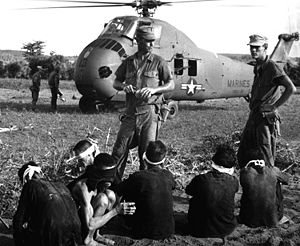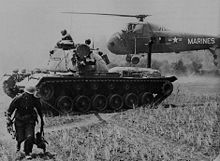- Operation Starlite
-
Operation Starlite Part of the Vietnam War 
Vietcong prisoners await being carried by helicopter to rear area after Operation Starlite.Date August 17–24, 1965 Location Van Tuong, South Vietnam Result Indecisive (both sides claimed victory)[1][2] Territorial
changes15 miles south of Chu Lai on the border of Quang Tin and Quang Ngai Provinces Belligerents  United States
United States Viet Cong
Viet CongCommanders and leaders  Lewis W. Walt
Lewis W. Walt
Major General Oscar F. PeatrossNguyen Chon Strength 5,500
3/3, 2/4, 3/7 and 3/4 Marines Infantry Battalions2,000
1st VC RegimentCasualties and losses 46 killed, 204 wounded
NLF report: 919 killed or woundedUS report: 573 confirmed killed; 115 probably killed
9 captured[3][4]Operation Starlite was the first offensive military action conducted by a purely U.S. military unit during the Vietnam War. The operation was launched based on intelligence provided by Major General Nguyen Chanh Thi, the commander of the South Vietnamese forces in northern I Corps area. Lieutenant General Lewis W. Walt devised a plan to launch a pre-emptive strike against the Viet Cong regiment to nullify the threat on the vital Chu Lai base and ensure its powerful communication tower remained intact.
The operation was conducted as a combined arms assault involving ground, air and naval units. U.S. Marines were deployed by helicopter insertion into the designated landing zone while an amphibious landing was used to deploy other Marines, including a flamethrower platoon.
Contents
Background
The operation was originally called Satellite, but a power blackout led to a clerical error and a clerk working by candlelight typed "Starlite" instead.[4]
Vietnamese historians mostly mistake the name of the operation, calling it Anh sang sao which is a translation of Star Light.[5]
Order of battle
The operation was launched on August 17, 1965, involving 5,500 Marines of the 9th Marine Amphibious Brigade. The brigade comprised 2nd Battalion 4th Marines (2/4), 3rd Battalion 4th Marines (3/4) and 3rd Battalion 3rd Marines (3/3), and 3rd Battalion 7th Marines (3/7) - from the Special Landing Force and originally a reserve component) in an assault on the Viet Cong base near Van Tuong. The United States Navy's USS Galveston (CLG-3) and USS Cabildo (LSD-16) were available for naval gunfire support and 3rd Battalion 12th Marines was the artillery unit in direct support. USS Vernon County (LST-1161)embarked elements of the 3d Battalion, 3d Marines (Battalion Landing Team) (BLT) 3, under Lieutenant Colonel Joseph E. Muir, USMC, at Chu Lai, and sailed south along the coast to An Thuong, where she put the troops ashore in one phase of "Starlite."
Viet Cong forces comprised the 1st VC Regiment made up of the 60th and 80th VC Battalions, the 52nd VC Company, and a Company of the 45th VC Weapons Battalion. The total Viet Cong strength was around 2,000 men, and backed by several elite mortar units.
Battle
Mike Co., 3/3 was designated the blocking force and deployed on August 18, 1965 using LVT-5s to the operational area. When it landed on the beach, it marched 4 miles (6.5 km) to establish their blocking positions. 3/3 made an amphibious landing and were tasked with driving the Viet Cong towards the 2nd battalion 4th Marines who were to be lifted by helicopter into three landing zones west of Van Tuong. Secrecy was paramount, and no ARVN commander or units were informed of the impending operation.
The Marines met light resistance moving into the attack, using their submachine guns to repulse occasional Viet Cong raiders. Echo Company, 2/4 spotted Viet Cong in the open and called in artillery fire from 3rd Battalion 12th Marines. The artillery barrage was reported to have killed 90 Viet Cong, including crippling several of their mortar units. Hotel Company,2/4 assaulted the 60th VC Battalion who put up a vicious fight, only being overwhelmed when attack helicopters swooped on their position, peppering it with rocket and machine gun fire. One prisoner was taken and 40 weapons were captured. India Company, 3/3 attacked An Cuong after receiving heavy fire from the hamlet and losing their company commander in the engagement.
India Company was ordered to join Kilo and Hotel companies and clean up any opposition but was caught in a crossfire from Nam Yen Dan Hill 30. Hotel Company established a defensive perimeter and were told to await reinforcements. The expected reinforcements, were diverted to assist the supply column that was ambushed west of their position. Recoilless rifle fire from the VC positions tore into the 5 LVTs and 3 flame tanks, forcing the Marines to mount a rescue. The Marines were hit by intense mortar and rifle fire and suffered 5 dead and 17 wounded. They called in artillery and air support to suppress the mortar and automatic fire, F-4 fighter jets dropping cluster bombs, resulting in an avalanche on the hillside which wiped out many of the attacking rifle and mortar squads.
The developing engagement necessitated the deployment of Lima Company, 3/7 from the USS Iwo Jima to join India company to assist the ambushed supply column. Come nightfall, the Marines hunkered down into defensive positions. Scout units from of 3/7's Marines came ashore during the night and the battalion got ready for a morning assault on the Vietnamese positions. When they finally attacked they found the VC unit had retreated from the encirclement during the night, though pockets of resistance continued from other Viet Cong fighters holed up in bunkers and caves. Fightings ceased at nightfall.
Aftermath
The various Marine units reported killing 600+ enemy fighters. Nine prisoners were taken along with 42 suspected guerillas; 109 assorted weapons were seized. To the Americans, the battle was considered being a great success for U.S. forces as they engaged a Main Force Viet Cong unit and came out victorious.[6] Despite this, the National Liberation Front also claimed victory, announcing that they had inflicted 900 American casualties, destroyed 22 tanks and APCs, and downed 13 choppers.[7] In fact, the VC 1st Regiment was not yet totally wiped out, and the VC still had control over some hamlets in the peninsula.[citation needed]
The Marines admitted to have a total of 45 dead and 203 wounded.[8][9] Other sources cite U.S. loses as 54, comprising 52 Marines, a Navy Corpsman and a US Army Major who flew gunship support.[4][10] Corporal Robert E. O'Malley (3/3) and Lance Corporal Joe C. Paul (2/4) received the Medal of Honor for their actions during the operation.
Lessons learned from the battle include the knowledge that the daily allotment of 2 gallons of water per man was inadequate in the heat of Vietnam and that the M14 Rifle was too bulky for troops cramped into small personnel carriers.
See also
Notes
- ^ Vets With A Mission
- ^ (Vietnamese) http://www.lichsuvietnam.vn/home.php?option=com_content&task=view&Itemid=33&id=321
- ^ Still Asset Details for HDSN9902074
- ^ a b c Operation Starlite
- ^ (Vietnamese) Bách khoa toàn thư Việt Nam - Bach khoa toan thu Viet Nam - http://www.bachkhoatoanthu.gov.vn
- ^ Vets With A Mission
- ^ (Vietnamese) http://www.lichsuvietnam.vn/home.php?option=com_content&task=view&Itemid=33&id=321
- ^ http://www.marzone.com/7thMarines/Hst0101.htm/
- ^ Vietnam War > Events >Operation Starlite Begins
- ^ [1][dead link]
References
- Lehrack, Otto (2004). The First Battle - Operation Starlite and the Beginning of the Blood Debt in Vietnam. Havertown, Pennsylvania: Casemate. ISBN 1-93203-327-0.
- Simmons, Edwin H. (2003). The United States Marines: A History, Fourth Edition. Annapolis, Maryland: Naval Institute Press. ISBN 1-59114-790-5.
- Summers, Harry G. Historical Atlas of the Vietnam War. New York: Houghton Mifflin Company.
Categories:- 1965 in Vietnam
- Battles and operations of the Vietnam War
- Battles and operations of the Vietnam War in 1965
- Battles involving the United States
- Battles involving Vietnam
- United States Marine Corps in the Vietnam War
Wikimedia Foundation. 2010.

